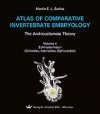![Atlas of Comparative Invertebrate Embryology, Volume 4: Echinodermata I (Crinoidea, Asteroidea, Ophiuroidea) Atlas of Comparative Invertebrate Embryology, Volume 4: Echinodermata I (Crinoidea, Asteroidea, Ophiuroidea)]()
Click to have a closer look
About this book
Contents
Customer reviews
Related titles
About this book
The Atlas of Comparative Invertebrate Embryology has two aims. Firstly, it describes embryonic development or ontogeny of several species within a phylum. Secondly, by comparing the different ontogenies this collection supplies a basis for phylogenetic reflections about phylum-level relationships in lower Metazoa. Diversity of ontogenies, embryos and larvae can be an important source for well-founded phylogenetic theories. Like comparative morphology and anatomy, comparative embryology plays a central role for the analysis of evolution.
The Atlas of Comparative Invertebrate Embryology presents a wealth of embryonic and larval developmental processes to emphasize the great variety of ontogenies in the animal kingdom. Like the adult organisms, larvae are also of an enormous diversity owing to the varied requirements of their environment. Within a phylum, embryonic and larval development may be uniform to a large degree, but also deviations are known. In comparing the different ontogenies of an animal phylum, embryologists try to find out the common ancestor and to reconstruct the phylogeny of the group.
Establishing a phylogenetic system of the animal kingdom on the basis of comparative embryology requires a sound theory to integrate far reaching steps in evolution of the animal phyla. Two theories, which are founded in simple events that equally occur in many embryonic developmental courses of different phyla, are the Gastraea–theory of Haeckel (1874) and the Archicoelomata–theory of Masterman (1898). In the Atlas of Comparative Invertebrate Embryology, the phylogenetic system proposed by comparison of the different ontogenies is based on these two theories.
The atlas offers a broad view about the diversity of embryos and larvae and may be useful in looking for a suitable species of special interest. Naturally, an exhaustive description of all ontogenies of animals is impossible. Ontogenies of well known species and detailed research work of their embryos have been chosen. Besides this, embryological research work of some Metazoan phyla is incomplete. Our knowledge of the ontogeny of animals is mainly founded on the classical investigations between 1860 and 1960. In the Atlas of Comparative Invertebrate Embryology, in the chapters concerning phylogenetic interrelationships of phyla, results of studies on morphological or biochemical composition of structures of the adults and of modern gene sequence data may be included into discussion.
Contents
Phylum Echinodermata 7
Class Crinoidea 7
O. Isocrinida 8
Metacrinus rotundus (CARPENTER) 8
O. Comatulida 9
Oxycomanthus japonicus (MÜLLER) 9
Antedon mediterranea (LAMARCK) 13
Tropiometra carinata (Lamarck) 18
Compsometra serrata (A. H. CLARK) 22
Isometra vivipara (MORTENSEN) 24
Notocrinus virilis (MORTENSEN) 26
Florometra serratissima (A. H. CLARK) 28
Summary of Embryonic Development in Crinoidea 31
Brooding, cleavage type, coelomogenesis, and organ differentiation 31
Larval types and metamorphosis 31
Class level relationship 32
Literature 32
Class Asteroidea 33
O. Paxillosida 34
Astropecten aranciacus (LINNÉ) 34
Astropecten irregularis (LINCK) 42
Astropecten scoparius (VALENCIENNES) 43
Astropecten latespinosus (MEISSNER) 46
Astropecten gisselbrechti (DÖDERLEIN) 47
Luidia quinaria (VON MARTENS) 49
O. Valvatida 52
Asterina pectinifera (MÜLLER & TROSCHEL) 52
Asterina gibbosa (PENNANT) 54
Asterina batheri (GOTO) 65
Asterina minor (HAYASHI) 69
Asterina pseudoexigua pacifica (HAYASHI) 72
Porania pulvillus (O. F. MÜLLER) 72
Odontaster validus (KOEHLER) 76
Acanthaster planci (LINNÉ) 77
Archaster typicus (MÜLLER & TROSCHEL) 78
Patiriella regularis (VERRILL) 80
Patiriella pseudoexigua (DARTNALL) 83
Patiriella exigua (LAMARCK) 84
Patiriella vivipara (DARTNALL) 89
O. Velatida 89
Solaster endeca (FORBES) 89
Crossaster papposus (MÜLLER & TROSCHEL) 94
Pteraster tesselatus (YVES) 98
O. Spinulosida 103
Henricia sanguinolenta (MÜLLER) 103
Echinaster echinophorus (LAMARCK) 107
O. Forcipulatida 109
Asterias vulgaris (PACKARD) 109
Asterias rubens (LINNÉ) 111
Leptasterias hexactis (STIMPSON) 118
Stichaster australis (VERRILL) 123
Summary of Embryonic Development in Asteroidea 126
Brooding, cleavage type, coelomogenesis, and organ formation 126
Larval types of asteroids 126
Metamorphosis 127
Asteroid larval types and evolutionary interpretation 127
Class level relationship of asteroids 128
Literature 128
Class Ophiuroidea 130
O. Phrynophiurida 131
Ophiomyxa brevirima (H. L. CLARK) 131
Gorgonocephalus eucnemis (MÜLLER & TROSCHEL) 131
O. Ophiurida 132
Ophiolepis elegans (LÜTKEN) 132
Ophiocoma nigra (ABILDGAARD) 133
Ophiocoma pumila (LÜTKEN) 137
Ophioderma brevispina (SAY) 138
Ophioderma longicauda (RETZIUS) 143
Ophionereis annulata (LE CONTE) 145
Amphiura chiajei (FORBES) 145
Amphipholis kochii (LÜTKEN) 146
Amphipholis japonica (MATSUMOTO) 148
Amphipholis squamata (DELLE CHIAJE) 150
Amphioplus abditus (VERRILL) 153
Ophiothrix fragilis (ABILDGAARD) 154
Ophiothrix suensoni (LÜTKEN) 158
Ophiothrix oerstedi (LÜTKEN) 158
Ophioplutei 160
Summary of Embryonic Development in Ophiuroidea 165
Brooding, cleavage type, coelomogenesis, and organ formation 165
Larval types in ophiuroids 165
Metamorphosis 166
Ophiuroid larval types and evolutionary interpretation 166
Literature 167
Glossary 168
Customer Reviews









































